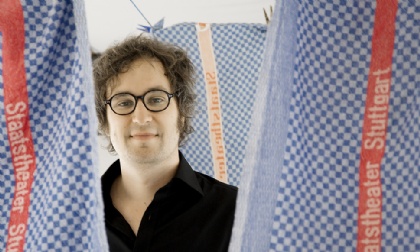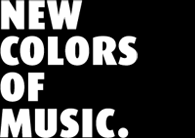 |
| A Horizon from Hendrix to Chopin - Hans Thomalla by Björn Gottstein |
|
by Björn Gottstein
What does Jimi Hendrix have to do with Frédéric Chopin? Not much at all, until they met in a piece by Hans Thomalla in 2004. You might think Chopin’s serene salon elegance would have no chance against Hendrix’s rock excesses. But in the course of his piece wild.thing, Thomalla perforates and disassembles the originals, until the manic drums and the melancholy piano voice permeate each other. The uninhibited, but then completely solitary drum beat and the aimless piano suddenly become part of a common gesture.
wild.thing is typical in many ways for the aesthetic horizon which forms the background to Thomalla’s compositions. On the one hand, the composer, who was born in Bonn in 1975, alludes to his generation’s aesthetic openness: where Thomalla brings together different, historically disparate sounds, he does not exclude popular culture. And on the other hand, the material Thomalla chooses usually comes from a particular meaningful context, giving his work a semantic framework. When, in Momentsmusicaux, he juxtaposes a passage from Brahms’s clarinet quintet with several figures from a study by Theobald Böhm, the intimacy of chamber music meets up with the rationalised acoustic idea of the virtuoso flautist, internalisation meets up with externalization. Thomalla makes this contradiction the departure point for a musical movement, it becomes the beginning of a "semantic drift" during which the "conceptualisation of sound gradually slips away" (Thomalla) and something new and individual comes into being.
When he quotes Brahms or Chopin, Thomalla enriches his works with a certain historical aura. Even a tonal chord is enough to explode the avant‑garde soundscape. For Thomalla, history is never historicism, but rather a way of ascertaining his own position. He refuses to adopt traditional stylistic elements uncritically – be it a certain sound or rhetorical flourishes – and works against the "sell-off of semantic clichés" (Thomalla). The historic reference becomes tangible in the figure of Bebung [trembling], which serves not only as a baroque ornament, but also as an emotional category of the musical subject in the string trio of the same name; or in Ausruff – a dispositive, with which he fathoms the acoustics of sforzando, the rhetoric of shock, and the sheer emotion of the scream to discover what they have in common.
Acoustic phenomena such as Rauschen [noise] can become objects of interest in the same way as musical forms such as the character piece in Stücke Charakter and the Albumblatt in the string quartet of the same name. In the series of compositions Counterparts on the other hand, the abstract musical figure is confronted with the materiality of the instrument: the bow of the cello seems to rebel against the melody; the uncontrolled hopping movement of the superball attached to the top of a mallet makes a well-formed rhythmic scheme impossible. In addition, Thomalla’s musical questions tie up with social, sometimes positively existential questions. When he determines foreignness in his opera Fremd as an aesthetic and political position, it is in the knowledge that he too experiences his material as “something foreign”.
Thomalla once described himself as a speechless rhetorician. That is correct, in so far as he is at first an observer of his chosen historic material and therefore speechless. It is not until the analytic act of composition that he perceives language, his own and others. And then Thomalla is of course, not a “speechless rhetorician” – not only because he is capable of speaking so eloquently and intelligently about music, but also because he gives his works a personal signature, just as if thinking about music had its own specific sound. |
 |
 |
|
| Photo: Manu Theobald © Ernst von Siemens Musikstiftung |
|
 |
|
Opera in three scenes, intermezzo and epiloque
Commissioned by the Staatsoper Stuttgart
Recording of the premiere performance on July 2nd 2011 and from July 6th 2011, Staatsoper Stuttgart.
General Director Albrecht Puhlmann | Conductor Johannes Kalitzke | Director, Set and Costume Anna Viebrock | Assistant Director Ludivine Petit | Chorus Michael Alber | Light Reinhard Traub | Sound Dieter Fenchel | Video Hans-Peter Böffgen, Judith Konnerth | Dramaturgy Sergio Morabito | Live-Electronics Forum Neues Musiktheater, Andreas Breitscheid
Medea Annette Seiltgen (soprano) | Jason Stephan Storck (bass) | 1. Kind Julia Spaeth (soprano) | 2. Kind, Carlos Zapien (tenor) | Argonauten Soloists of Staatsopernchor Stuttgart
Staatsorchester and Staatsopernchor Stuttgart |
2SACD | Opera | Contemporary | Ernst von Siemens Musikstiftung |
|
 |
 |
| Recommendation |
|
|
|
|
Remembrance and Polyphony. Ernst von Siemens composer’s award winner Ulrich Alexander Kreppein.  |
 |
|
|
|
|
Ultimately taking shape in a multitude of aesthetic blueprints, in which many different musical approaches can be realized.  |
 |
|
|
|
|
A tamer and a charmer of tones, a ringmaster and a magician!  |
 |
|




